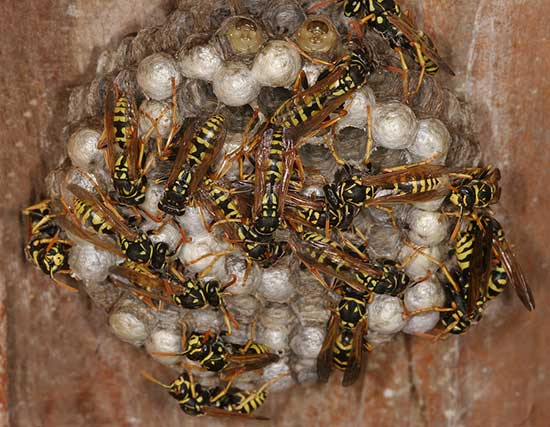
Within 3-5 days, the pupae reach adulthood, resulting in a rapid lifecycle. Adult wasps have a lifespan ranging from a few weeks to up to a year for queens. The high level of activity within a wasp nest during summer emphasizes the critical role of the queen in producing a large number of eggs, fostering the rapid growth and prosperity of the nest.
Wasps belong to the Hymenoptera order, which encompasses bees and ants. They are carnivorous insects that prey on other insects, spiders, and small animals. Additionally, adult wasps have a preference for sweet substances like fruits and sugary beverages. Explore the fascinating world of wasps and their dietary habits!
Lifecycle of a nest.
A single queen is all it takes to establish a nest for her colony. She begins by creating internal cells and producing the first set of workers who will eventually take over foraging duties. This allows the queen to solely focus on egg-laying, producing hundreds each day. As the population expands, the growth rate gradually slows until the nest reaches a climax, where growth ceases entirely. At this stage, the colony constructs new queen cells in preparation for the next phase of their lifecycle. Explore more about the fascinating process of colony formation and development here.
When new queen cells are constructed, the queen initiates the production of queen larvae, while the foraging rate of worker wasps increases. However, the queen’s health gradually deteriorates, and there is a possibility of her demise, resulting in the collapse of the nest’s colony. The wasps exhibit erratic behaviour and resort to cannibalism, ultimately signifying the conclusion of the current cycle. Explore the intriguing dynamics of wasp colonies and the vital role of queens in their survival.
After the young queens depart the nest, they mate and enter hibernation until the following spring, initiating a fresh cycle of nest building and colony establishment. This repetitive process starts with a solitary queen and gradually reaches its peak before commencing anew. Discover the fascinating lifecycle of nests and colonies as nature unfolds its wonders.
The lifecycle of a wasp nest underscores the crucial role of the queen in constructing and sustaining the colony. After the queen fulfils her duties, the colony prepares for the next phase by constructing new queen cells and facilitating the mating and hibernation of the young queens. This intricate process ensures the survival of the colony and the perpetuation of the species, making it a vital aspect of wasp nest biology.
Characteristics of wasps
In the UK, the two most common types of wasps you may come across are the common wasp (Vespula vulgaris) and German wasps (Vespula germanica). These species are easily identifiable by their black and yellow stripes. If they feel threatened, both can deliver painful stings. Stay informed about common UK wasp species and their behaviour to ensure your safety.
Queen wasps are typically larger than regular wasps, reaching sizes of around 20mm. During winter, they hibernate and then emerge in spring to build their nests. These nests nurture their grubs, which are fed on insects, facilitating their growth into workers within a span of 3-4 weeks. Explore the fascinating world of queen wasps and their lifecycle! Invest in understanding their behaviour and nesting habits.
Sterile female worker wasps diligently forage for food, sometimes venturing up to a mile away. As the year winds down and temperatures drop, food sources dwindle, leading to rapid wasp mortality due to both hunger and the cold. Stay informed about the fascinating life cycle of these industrious insects!
Control of wasps
Ensuring effective pest control is crucial for dealing with wasp nests in residential and commercial settings. These nests pose a significant threat to humans and pets due to the risk of allergic reactions from wasp stings. Timely treatment is essential as untreated nests can rapidly grow, making the eradication process more challenging and hazardous. Protect your home or business by addressing wasp nest infestations promptly.
The presence of wasps can have a significant impact on your business, outdoor spaces, activities, and events. It is highly recommended to avoid attempting to remove a wasp nest by yourself due to the inherent dangers involved. In most cases, a professional wasp nest treatment is sufficient, and wasp nest removal may not be necessary. However, if the nest is easily accessible, it can be safely removed approximately a week after treatment, ensuring it is completely inactive. During the winter and spring months, if you come across a nest, such as in your loft, it is likely to be abandoned and no longer inhabited by wasps. Wasps do not reuse nests, so it is safe to assume that the nest is dormant and inactive. Ensure the safety of your surroundings by addressing wasp-related concerns promptly and professionally.
It’s always important to consult with a professional, like The Pest Master, for effective wasp nest treatment. Our skilled experts have the knowledge and specialist equipment needed to handle the job. Contact us today to get rid of wasp nests swiftly and safely.
